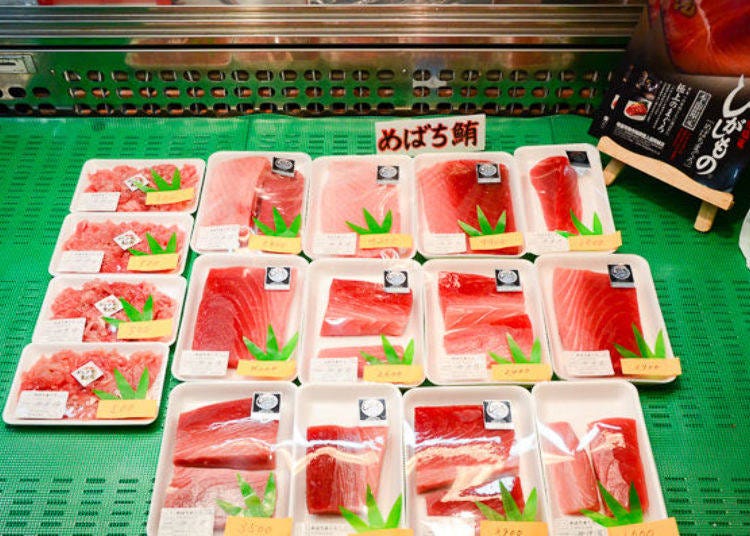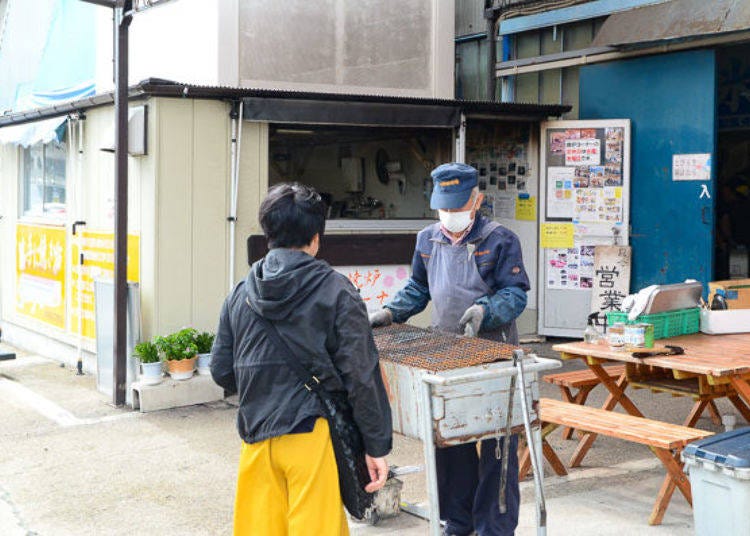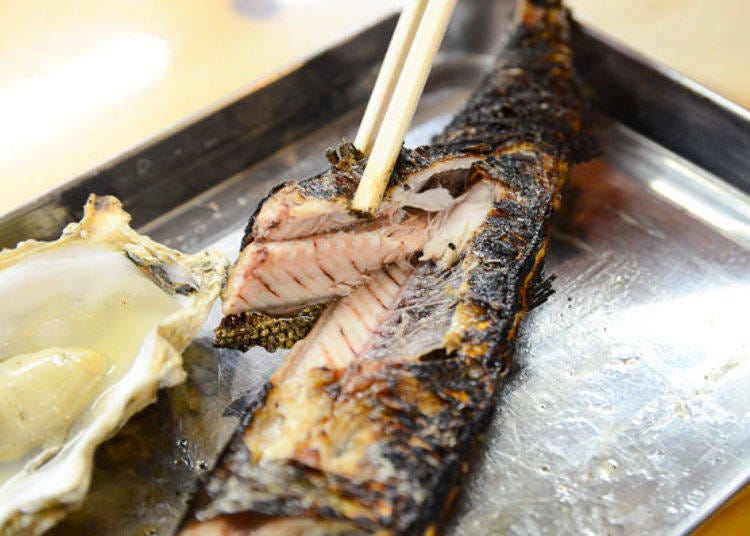
Shiogama Port in Shiogama City, Miyagi Prefecture once prospered as a base for northern ocean fisheries and still boasts being one of the areas in the nation having the largest hauls of fresh tuna.
The Shiogama Seafood Wholesale Market is the center for its distribution. The Mai Kaisen-don [My Seafood Bowl] and Jiyu Shoro [Grill It Yourself] dishes made with seafood products purchased at the market are very popular! We also tasted the Sanriku Shiogama Higashimono brand bigeye tuna which is distributed only for a limited time from mid-September to December.
- Table of Contents
-
- Nostalgic wholesale market jam-packed with 105 seafood specialty stores
- Aisle upon aisle of Sanriku seasonal seafood! Let’s walk from one end to the other
- Discover the secret behind the popularity of the Sanriku Shiogama Higashimono brand of tuna!
- Buy as much as you like! Then make yourself a heaping My Seafood Bowl
- No need to bring anything to enjoy a seafood barbecue at the Jiyu Shoro [Grill It Yourself] Corner
- There is still even more to enjoy at the wholesale market. There are places to eat and also events.
Nostalgic wholesale market jam-packed with 105 seafood specialty stores
The Shiogama Seafood Wholesale Market is approximately 35 minutes by car from Sendai City, and when coming from outside the prefecture, approximately 15 minutes from the Sanriku Expressway and Rifucho IC. If you go by train, get off at JR Sengoku Line, Higashi Shiogama Station and walk for about 15 minutes, or ride the Shionabi bus for about 5 minutes. Just outside Shiogama Port, large trucks come and go on the broad road in front of the port.

More than 50 years have passed since its establishment in 1966, and the building has a feel to it that much time has passed. Despite the port's immediate vicinity, it escaped damage when the tsunami caused by the Great East Japan Earthquake hit and remains today in its original form. Now that the Tsukiji market has been closed due to its relocation to Toyosu, this has become one of the oldest wholesale markets in the country.

The interior has 105 specialty shops crowded into its 4,950 square-meter floor space (as of November 2018). There are 7 walkways going east to west and if you go up and down each one, you can see all the shops in the market.

Aisle upon aisle of Sanriku seasonal seafood! Let’s walk from one end to the other
Each shop is lined with seafood from such ports as Shiogama, Shichigahama, and Kesennuma. A unique feature of this market is the many shops specializing in particular marine products.
For example, there are about 20 shops that specialize in tuna with others specializing in octopus, shellfish, salmon, trout, frozen fish, processed food, dried fish, dried food, food in paste form, and shops specializing in delicacies. In addition, there is also a shop that specializes in containers for serving sashimi.






The day we visited we saw wholesalers mingling with lots of regular customers even though it was a weekday. I did not expect to see so many young people; many appeared to be university students or in their early twenties. There were also families with children as well as long-time regular customers who have been shopping here for many years - all in all a broad spectrum of society.

The offshore area of Miyagi Prefecture is rich in marine resources as the Kuroshio (warm current) and Oyashio (cold current) meet there. Because of the rich hauls caught here, the offshore fishing grounds of Kinkazan and Sanriku are one of the three largest fishing grounds in the world. In addition, the aquaculture industry along the coast is prosperous, and the production by prefecture is fourth largest in the whole country (Ministry of Agriculture, Forestry and Fisheries "2016 Sea Surface Fishery Production Statistics").
The sight of all these various types of marine products all lined up so close together is a spectacular one.


As you pass by a shop looking at its display of seafood, the storekeeper will call out saying, "Today we are recommending this." You can taste samples, bargain with them, and they will tell you the best ways to fillet and eat products. Interacting with vendors in this way is one of the joys of visiting here.

Discover the secret behind the popularity of the Sanriku Shiogama Higashimono brand of tuna!
Let's see what makes Sanriku Shiogama Higashimono, which from now we will just call Higashimono, so popular. Of the bigeye tuna that are landed at Shiogama Port from mid-September to December, only the most carefully selected ones are referred to as Higashimono. "Higashi" refers to the area off Sanriku Higashi, which is a fishing ground where delicious bigeye tuna is caught.

The Higashimono is a fishing ground off Sanriku East, where the Oshio and Kuroshio currents meet, and among the bigeye tuna that are caught in longline fishing these are superior in color, luster, fat content, and taste. Furthermore, two strict conditions must be met in order to be certified as Higashimono: the weight must be over 40 kg and go for an auction price of more than 2,000 yen per kg.
As only 5 to 10 fish out of 100 are certified as Higashimono, there is not enough to provide retail shops and restaurants with a stable supply, so for that reason there is not much distribution. Most of it goes to sushi shops in Shiogama and only a few other shops in Sendai receive it while outside the prefecture it is virtually impossible to find. At one sushi shop in Tokyo a single kan [individual sushi serving] costs 1,000 yen!

We asked Mr. Toshiyuki Matsuoka, the third generation shop owner of tuna specialty shop Matsuoka Shoten, about Higashimono. "Bluefin tuna is considered to be the best while bigeye tuna is considered less so, but even with bluefin tuna there are good and bad types. This season's Higashimono is really good with good bluefin tuna not far behind it," he clearly stated.

When asked about flavor, “The best way to determine that is to actually taste it. I always tell customers ‘Taste it for yourself’,” he said. And he is right.

Buy as much as you like! Then make yourself a heaping My Seafood Bowl
We decided to follow Mr. Matsuoka’s advice and try the Higashimono. The Shiogama Seafood Wholesale Market is famous for being able to make your own My Seafood Bowl. This is a dish you make yourself by first selecting and purchasing sashimi of your favorite seafood offered in the market.
The seafood bowls that are served in shops are beautifully balanced, but if you are not good at arranging the slices of seafood, it doesn't come out looking as well. Some people like to just stuff themselves with only a single type they like. Whether you like one or many types of sashimi, the My Seafood Bowl would be good for you!

First buy sashimi that is sold in packs at a shop in the market. You can also ask shopkeepers to make sashimi from whole seafood items and blocks of fish on the spot. After you get the plastic bag with your purchases, continue looking for more seafood items to put in it.

After you have completed making your purchases, proceed to the My Seafood Bowl Corner in the No. 6 sales area. Here you can purchase the Gohan Set which includes rice and miso soup (regular 400 yen, large 500 yen, special 600 yen, and for another 200 yen you can get tuna soup instead of miso soup; all prices include tax).
![▲ At the My Seafood Bowl Corner (open from 6:30 a.m. ~ 12:00 p.m.; *Saturdays, Sundays, holidays until 1:00 p.m.; closed on Wednesdays) you can also purchase Tendon [tempura bowls] and set lunches in addition to the My Seafood Bowl sets](https://rimage.gnst.jp/livejapan.com/public/article/detail/a/30/00/a3000017/img/en/a3000017_parts_5d43cc85b2b99.jpg?20201111161714&q=80)
Once you make your purchase you can load up your bowl.

Including the Higashimono, it all came to about 5,000 yen, but there was enough sashimi for 3 or 4 people, so much so that I couldn’t put it all on the bowl. I hear that many young people in groups of 4 ~ 5 people like to share, so the price per individual then is not all that expensive.

Now for the moment of truth. The Higashimono had a pleasant, soft texture that made it melt in the mouth with each bite. The umami of the tuna was clearly defined and the tuna left a refreshing aftertaste. The quality of the fat was good so there was no greasy aftertaste.

The other ingredients were also fresh and delicious. This bowl with all my favorite ingredients was so delicious that once I started eating it I couldn’t stop.

This was so good I felt like I was on Cloud 9.... When having fish for lunch, it is always good to have a little something on the side, so you can also buy canned beer (350 yen including tax), draft beer (500 yen including tax), and of course local sake such as Urakasumi (700 yen including tax).

When the My Seafood Bowl Corner opened in 2010 the space could only seat about 20 people. However, after the earthquake, many people who visited the area to help with reconstruction came here to eat and as they shared their experiences on SNS, the number of visitors steadily increased. Currently there is now space for about 100 people and its popularity is such that on Saturdays and Sundays between morning and noon it fills to about 80% of capacity.
No need to bring anything to enjoy a seafood barbecue at the Jiyu Shoro [Grill It Yourself] Corner
Another place where you can enjoy the seafood you have purchased in the market is the Grill It Yourself Corner (open from 8:00 a.m. to 12:00 p.m. and from 1:00 p.m. on Saturdays, Sundays and public holidays). You can freely use the outdoor grill to cook fish, shellfish, shrimp, squid, dried fish and other items you bought in the market. This is especially popular with children and others who are not partial to raw food.

Shellfish can be placed directly on the grill (100 yen including tax for up to 5pieces) and fish are grilled between wire mesh (1 mesh per fish, 100 yen including tax).



The saury and oyster after they were carefully cooked on the grill. The far-infrared-grilled saury was fragrantly plump and juicy. The oyster was full of flavor and plump. The full flavor of these ingredients grown in the seas of Sanriku was fully brought out. You can’t make it this well at home.


Some people put grilled seafood and sashimi packs in a rice set and eat it like a set meal. That is also an interesting way to do it. One of the attractions is being able to try something different each time you visit. I thoroughly enjoyed walking around the spacious interior, selecting seafood for a bowl of my own creation, and barbecuing, too, as though I were in a food theme park.
There is still even more to enjoy at the wholesale market. There are places to eat and also events.
In addition to the My Seafood Bowl Corner, there are three restaurants within the market, all of which offer a menu using fresh seafood from the market.

![▲ Kato Shiogama Market Shokudo Shop (Open: 7:00 a.m. ~ 1:00 p.m., Saturdays, Sundays and public holidays until 2:00 p.m., closed on Wednesday). In addition to its famous Marugoto Maguro-don [all tuna bowl], limited to ten servings per day, and the Yaki Anago-don [grilled conger eel bowl], the restaurant offers a wide selection of other menu items such as the Omakase Sanshoku-don [3-color leave-it-to-us bowl] and Chu Toro & Anago Sashimi-don [medium-fatty tuna and conger eel sashimi bowl].](https://rimage.gnst.jp/livejapan.com/public/article/detail/a/30/00/a3000017/img/en/a3000017_parts_5d43cdce7828f.jpg?20201111161714&q=80)
Every year around October (September 30, 2018), the Shiogama Fish Market Open Dotto Festival is held once a year sponsored by the Shiogama Fish Market and the Shiogama Seafood Wholesale Market. There are tuna filleting shows, make-your-own tekamaki [tuna sushi roll] experiences, grabbing live tuna, and simulated tuna auctions. It is attended by so many people that there is always a line of cars waiting to find a parking space.
In addition, every week there is a Sunday Morning Market (6:00 a.m. to 2:00 p.m.) where farmers sell seasonal fruits and vegetables.

The Shiogama Seafood Wholesale Market is where tuna and seafood caught in the port of Sanriku are brought together in one place. I enjoyed the atmosphere of the lively venue, interacted with the shops, got fresh seafood at a great value, ate until I could not eat another bite, and thoroughly enjoyed myself. Please definitely pay a visit to this facility where you can discover, eat, and enjoy the delicious seafood taken from the abundant waters of Sanriku.

-
Shiogama Seafood Wholesale Market塩釜水産物仲卸市場
- Address 1-20-74 Shinhama-cho, Shiogama City, Miyagi Prefecture
- Phone Number 022-362-5518
Open: weekdays 3:00 a.m. ~ 1:00 p.m., Saturday 3:00 a.m. ~ 2:00 p.m., Sunday and holidays 6:00 a.m. ~ 2:00 p.m. (Hours vary according to shops in the facility)
Closed: Wednesday (During Golden Week and the latter half of December it is open on Wednesday), Jan. 1 ~ 4, August 14 ~ 16
- Area
- Category
*Prices and options mentioned are subject to change.
*Unless stated otherwise, all prices include tax.
Popular Tours & Activitiess
Recommended places for you
-

Akiu Onsen
Hot Springs (Onsen) & Bath Houses (Sento)
Sendai And Matsushima
-

Zuiganji Temple
Temples
Sendai And Matsushima
-

Koiwai Farm
Other Nature
Morioka, Hiraizumi And Hachimantai
-

Matsushima Bay
Landscapes
Sendai And Matsushima
-

Asamushi Onsen
Hot Springs (Onsen) & Bath Houses (Sento)
Aomori, Hirosaki And Hachinohe
-

Sendai Tanabata Festival
Japanese Festivals (Matsuri)
Sendai And Matsushima
-
Ad

Advice from the Experts at Hitohira: Here's How to Choose the Best Japanese Knife
-

Dining in Yamagata: Must-Try Foods & Top Restaurants Near the Station
by: ShiroKu inc.
-
Ad

Just one stop from Haneda Airport! "Truly Japanese!" Food, Fun, and Knowledge Gather at HICityⓇ Enjoy An Electrifying Night at "Japan Night Fever: Haneda Innovation City"
by: Yohei Kato
-

Shopping in Niigata: 9 Must-Buy Souvenirs & Local Sake to Take Home
by: ShiroKu inc.
-

Niigata Sake no Jin 2026: Guide to Japan's Most Legendary Sake Weekend
-
Ad

Why Fukushima is the Next Big Food Destination in Japan The Foodie Paradise Only 90 Minutes from Tokyo
-

Iizaka Onsen Guide: Japan's Gorgeous Hidden Hot Springs Town! (Access, Things to Do, Ryokan)
-

One Taste of These Miyagi Oysters and You Won't Want to Eat Seafood Anywhere Else! (Best Oct-Mar)
-

Great Sushi in Sendai: 3 Restaurants Serving Incredible Fresh Seafood in Tohoku's Top City
-

These 5 Sado Island Restaurants Will Rock Your Vacation
-

JR Edition: Visit all of Tokyo in one Day with the Tokyo Metropolitan District Pass!
-

The Best of Japan: 11 Major Cities Every Traveler Should Visit












